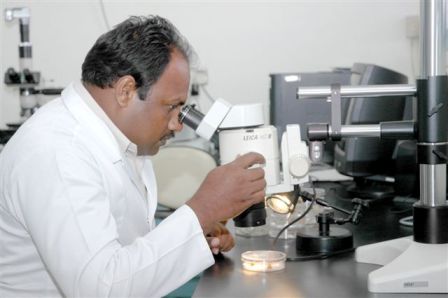Health diagnosis of cultivated chickpea and wild relatives
Contributors to this page: ICRISAT, Patancheru, India (Hari D Upadhyaya, Shivali Sharma, Cholenahalli L Laxmipathi Gowda, Dintyala Sastry, Sube Singh); NBPGR, New Delhi, India (Shyam Sharma); ICARDA, Aleppo, Syria (Ahmed Amri, Kenneth Street, Natalya Rukhkyan), SARC-RIPP, Piestany, Slovak Republic (Gabriela Antalikova); Institute of Plant Genetic Resources ‘K.Malkov’, Sadovo, Bulgaria (Siyka Stoyanova); Department of Primary Industries, Victoria, Australia (Bob Redden); IPK, Gatersleben, Germany (Andreas Börner).

Germplasm seed health testing (photo: ICRISAT) |
List of pests and diseases of quarantine importance
Click here for more detailed outputs from the page of the safe transfer of germplasm, on this site.
The list below mentions some of the pests/diseases that were considered important worldwide, but many of them may or may not have relevance in specific countries. It also does not consider pests/diseases of limited relevance (e.g. only important in very few countries).
Insects
- Kapra beetle (Trogoderma granarium) (Papua New Guinea).
- Bruchids (Callosobruchus chinensis L.).
Fungus
- Ascochyta rabiei (Chile and Mauritius).
- Pod and stem blight (Phomopsis longicola) (India - www.Plantquarantineindia.org).
Bacteria
- Pseudomonas syringae pv pisi (Iran and Kenya).
- Corynebactirium flaccumfaciens (Madagascar).
Virus Pea seed borne mosaic poty virus (Malawi and Israel).
- Alfa-alfa mosaic virus (Malawi and Israel).
Options for testing procedures
Recommended methods to detect the presence of each pest or disease:
- Kapra beetle (Trogoderma granarium) - Visual examination.
- Alternaria alternate - Freezing blotter method, PDA.
- Botrytis cinerea - PDA.
- Colletotrichum dematium - Paper toweling.
- Fusarium wilt (Fusarium oxysporum f. sp. ciceris) - Freezing blotter method, PDA.
- Phoma medicaginis - Freezing blotter method, PDA.
- Rhizoctonia bataticola – PDA.
- Ascochyta rabiei - Agar plate; Freezing blotter method.
- Pseudomonas syringae pv pisi and Corynebactirium flaccumfaciens - Agar Plate, Biochemical and PCR.
- Pea seed borne mosaic poty virus and alfa-alfa mosaic virus - ELISA and Electron Microscope, Growing them out.
- Orobanche spp.- Filter wash test.
- Cuscuta spp. - Filter wash test.
- Xanthomonas cassiae - Semi-selective medium.
- Bruchids (Callosobruchus chinensis L.) - Visual examination.
Testing intervals/seasons
- Testing before material goes into the genebank or to the field is important to reduce transfer of diseases or pests.
- Plants should be tested at 7-32 days based on the type of testing procedures (according to the Germplasm Exchange and Quarantine of ICRISAT Mandate Crops).
However, under natural field conditions, the following best practices are recommended:
Ascochyta rabiei
- Field inspection at all stages, followed by rouging off infected plants or/and seed health testing.
Alternaria alternate, Botrytis cinerea, Colletotrichum dematium
Fusarium wilt Fusarium oxysporum f. sp. ciceris
Phoma medicaginis
Rhizoctonia bataticola
- Field inspection all stages, rouging and seed health testing.
Orobanche spp., Cuscuta spp.
Xanthomonas cassiae
- Field inspection at flowering stage, rouging before seed dispersal and burn the plants.
Recording information during health diagnosis
The following information should be recorded for each health diagnosis step:
- Accession name (unique identification of the accession).
- Date of testing and examination [date of test and recording observations (dd/mm/yyyy)].
- Field number (to record the history of the field).
- Method of testing (method followed).
- No. of seeds tested (e.g. 50).
- Germination % (percentage of seeds germinated).
- Pathogens detected (record on pathogens identified).
- Percent of seed infected (percentage of seeds with infection to the number of seeds tested).
- Remarks (any other observations).
References and further reading
Chakrabarty SK, Anitha K, Girish AG, Sarath BB, Prasada RRDVJ, Varaprasad KS, Khetarpal RK, Thakur RP. 2005. Germplasm Exchange and Quarantine of ICRISAT Mandate Crops. Information Bulletin No. 69. Rajendranagar 500 030, Andhra Pradesh, India: National Bureau of Plant Genetic Resources; and Patancheru 502 324, Andhra Pradesh, India: International Crops Research Institute for the Semi-Arid Tropics. 80 pp. ISBN 92-9066-481-9.
Comments
- No comments found





Leave your comments
Post comment as a guest